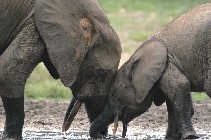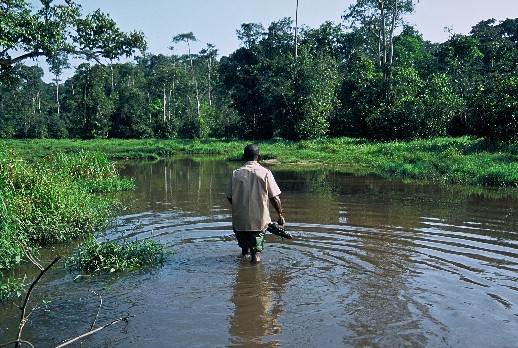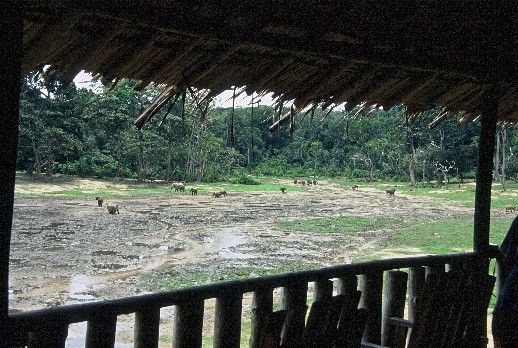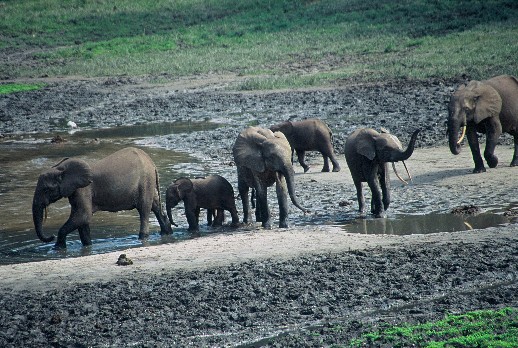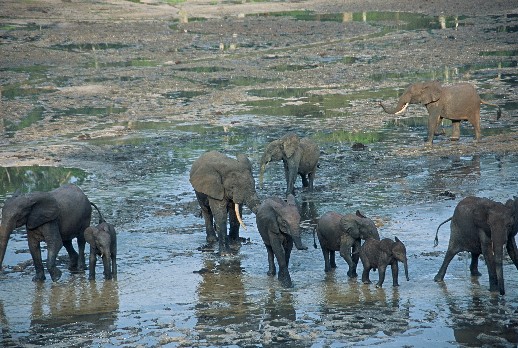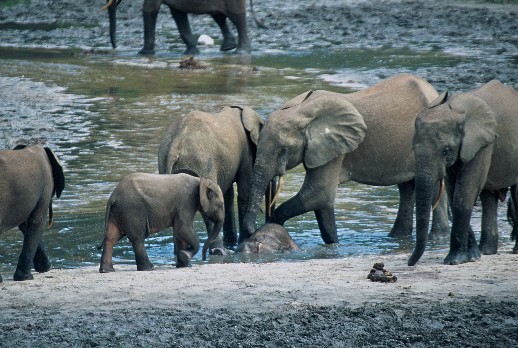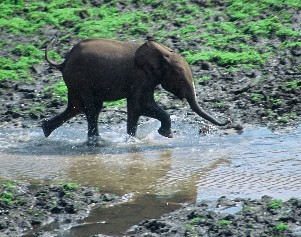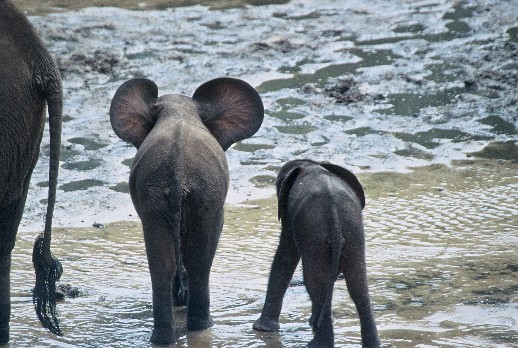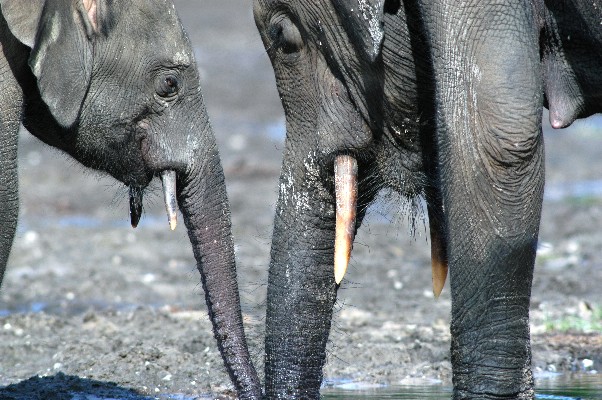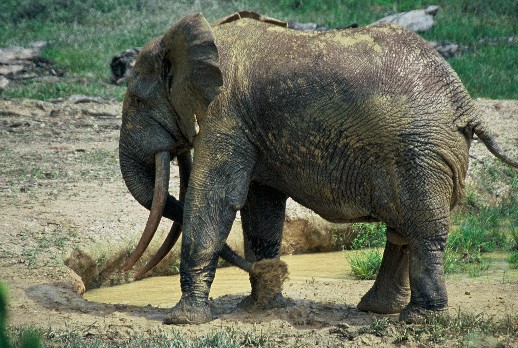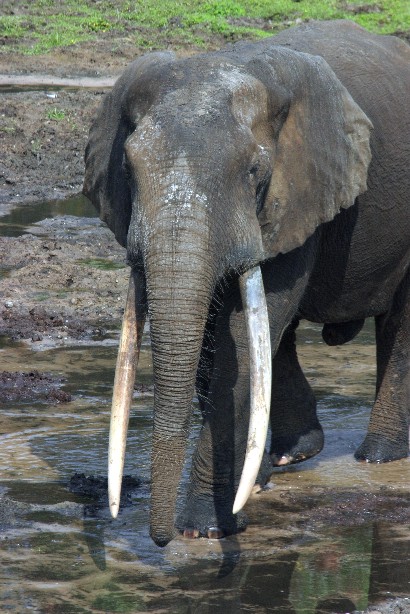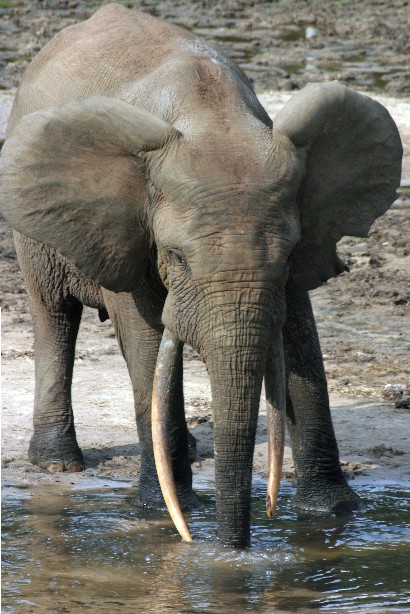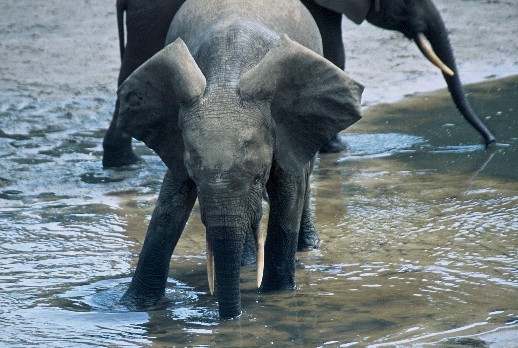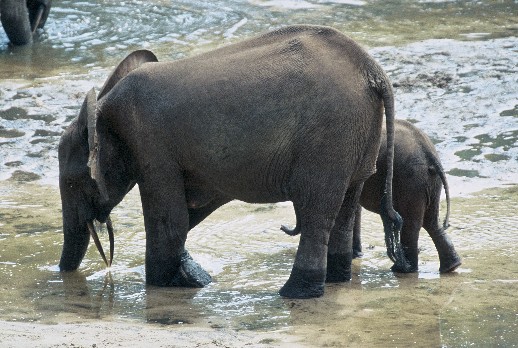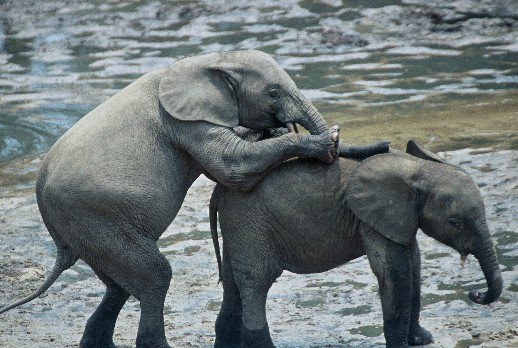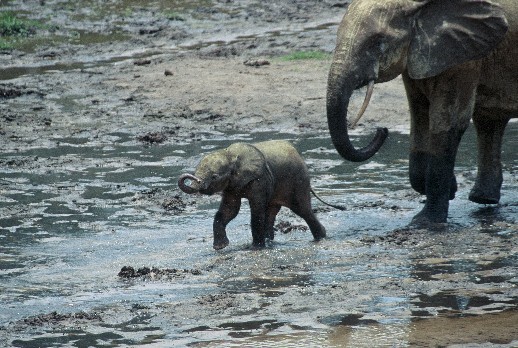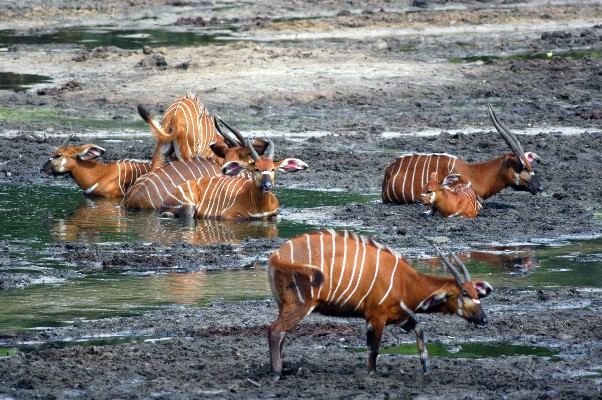Elephant Heaven
Being in the mirador was like having front row seats for the greatest show on earth with the most fantastic set design imaginable. Below us was a scene of indescribable natural beauty. The backdrop was dark, concealing green forest. Centre stage was what looked to me a muddy quagmire; to the elephants it was heaven.
We were in Dzanga bai (bai is the local word for a saline or clearing in the forest), an elephant oasis in the middle of the rainforest in equatorial Africa, more specifically the Central African Republic. Many other clearings exist in the immediate vicinity of Dzanga, but none is known to consistently attract so many animals – elephants, sitatungas, giant forest hogs, forest buffalos, various species of monkey and duikers – thus making Dzanga an internationally exceptional site.
In spite of its international renowned, Dzanga is not an easy part of the world to access. It had taken us several hard days travelling through Cameroon and CAR; we had endured hours of unrelenting forest scenery, suffered interminable delay at the hands of bored officials. But such trials are all part of the rich tapestry of travel and made reaching our final goal all the more worthwhile.
Standing in front of our guide, Jean Bernard, the fatigue of travel seemed to lift. Expectation was high as Jean Bernard explained that we had a walk of some fifty minutes through the forest to reach the bai. He told us that there was a strong chance that we would confront animals. If we met an elephant we were to watch him and follow his actions (whilst at the same time looking to see where the nearest large tree was, I thought to myself). If we saw a gorilla we were to kneel down and avoid eye contact. If we saw a leopard we were to gather around him, he said with a grin.
Duly warned we set off into the forest. Surrounded by the submarine darkness of the forest, the dappled light shining through the canopy, everything was heard but unseen. The short-wave squawking of grey parrots overhead, the barked warning of the grey-cheeked mangabey, and the incessant ringing of insects. We crossed a small river, wading through the smell of freshly disturbed stagnant water. Butterflies, in their thousands, flittered and fluttered colourfully around us. Large mounds of elephant dung lay scattered around. The spoor at the side of the stream revealed the presence of several young calves, even very young babies.
“Have you ever seen elephants whilst walking to the mirador?” I asked.
“Several times,” Jean Bernard replied.
“ Is it dangerous?”
“If the elephants see you it is no problem. But if they have young then it is dangerous.” This did little to reassure me given the tracks that we had just seen.
A scream, a sudden thundering of hooves and crashing of undergrowth made my heart leap. My pride fell when I saw that it was a blue duiker, a small forest antelope barely two feet tall that was marginally more terrified than I was.
And then we emerged into Dzanga bai, a small clearing in the forest of some two hundred metres by five hundred metres. Less than thirty metres away were a family of elephants. In hushed awe we climbed the wooden steps to the mirador, a raised wooden platform that afforded us a view hitherto seen by only a handful of researchers and wildlife documentary makers. Amazing as documentary footage is, it belies the immediacy, the actuality of being there – the phenomenal sounds, the wonderful sights.
There were some thirty elephants in the bai. This number was to fluctuate throughout the day: at midday there were only a handful of elephants in the bai whereas later in the afternoon there were over eighty. Although it was fantastic to see such numbers of elephants I was more interested and entertained by simply watching them, noticing and observing detail. The pinkness of one baby’s feet. The lazy swishing of a tail, the uncoordinated flopping of a baby’s trunk, the deliberate spraying of mud by a lone male. Adults raised their trunks, scenting new arrivals, heads were touched, trunks entwined and caressed in greeting. Youngsters, carefree and playful, chased each other around, splashing and sloshing in the water with gay abandon.
Such scenes are perhaps not uncommon across Africa with savannah elephants but much less so with more skittish forest elephant. Products of their environment, there are a number of features that distinguish the forest elephants from their savannah cousins. The forest elephant is slightly smaller, both in terms of size of its body and also its ears. The savannah elephant is taller above the front legs whereas the forest elephant is taller above the back legs. The forest elephant has straighter tusks. The forest restricts the potential for larger groups and thus the size of forest elephant herds is small, social groups being up to fifteen individuals.
It was incredible not only to see such large numbers of forest elephants but also to hear how vocal they were. Trumpeting resounded and resonated around the small clearing as new arrivals entered the saline. The deep rumbling of recognition, the more anxious rumble of distress as a calf looked for Mum – amazingly a female walked out from amongst the crowd to the obvious relief of the distraught calf. The Jurassic roar of a bull as he angrily chased away a mischievous youngster.
The elephants come to the saline for nutrients, as they do not get enough from the forest. Scientists refer to this as geophagic reasons, geophagy being the consumption of dirt, and particularly mineral-rich dirt (with sodium, calcium, magnesium, potassium, phosphorous and manganese) and clay. Dirt consumption allows the elephants and other herbivores to overcome mineral deficiencies and imbalances in their diet.
Of all the species observed in the clearing, the elephants are the most efficient ‘miners’ of the salt. The salts lie in solution at the bottom of water-filled holes and the elephants obtain the salts by digging or pumping the mineral-rich water using their trunks to reach the water covered layer of dolerite. I watched an elephant kneel down and with a flick of its head pile drive its trunk down into the water-filled hole. The process was repeated again and again until sufficiently deep. She then, blowing bubbles into the water, emptied her trunk of air before sucking up the salts. The noise from the blowing is part of Dzanga’s sound environment just as is the trumpeting or other various social cries emitted by the elephants.
Dzanga bai gives exceptional access to the intimate world of elephants and the study of their social behaviour. Dzanga bai is where the Rosetta Stone of elephant speak is being etched rumble-by-rumble and shriek-by-shriek. And nobody knows the elephants better than Andrea Turkalo. She is able to recognise shrieks that indicate subordinance, the deep-throated rumble of Jonas, advertising his testosterone-charged “musth” status. In all, Andrea has identified some thirty different vocalisations from contact to protest to fighting.
Andrea came to Central African Republic some twenty years ago as a Peace Volunteer and has been studying the elephants of Dzanga for the last fourteen years. During which time she has recorded some six thousand elephants and is able to identify some 3,300 elephants. She identifies elephants through a number of attributes such as design of the ear, including the visible holes and tears, length and shape of tusks, morphology of the tail, and scars on the body.
But Andrea’s knowledge is more than statistical. She knows many of the individuals personally. As we speak she pointed out a young baby. “That’s Kedi. Kedi means “little sister” in Ba’Aka, the local pygmy language. Look at how pink her feet are. She is so cheeky, so full of character. Not content with chasing sitatunga like the other youngsters I have seen her take on a buffalo, much to the alarm of her mother.”
Later that day, walking back through the stream we came across a lone bull in the water. Andrea motioned for us to stop. We stood in silence, paralysed with fear. Suddenly Andrea slapped the water with her machete. A loud, sudden crack like a rifle shot made me jump out of my skin but did little to disturb the elephant. Another slap of the machete, the elephant looked up, turned tail and slowly lumbered away from us. Danger averted, a sigh of relief and increased respect for Andrea. She knows and understands her subjects well.
Andrea’s research at Dzanga is important, as it is the first site where forest elephants are being systematically studied and monitored on a regular basis. Direct observations constitute the first data on this subspecies and have provided information specifically on the structure and dynamics of the population, the intervals between births and birth rate, social behaviour, biometrics, feeding ecology, and genetics.
It may sound technophile but the data collected by bioacoustic monitoring, where the cacophony of wild beasts and the quiet toil of conservation merge into one, will be applied to an important conservation problem: estimating the size and structure of this otherwise invisible population of forest elephant. So severe is the lack of information on forest elephants that their worldwide population estimates vary from 24,000 to 210,000.
Despite her vast knowledge and huge contribution to our understanding of the forest elephant, Andrea states that she is not a scientist but rather interested in conservation. When, later in conversation, Andrea describes in a matter of fact way that she would take a bullet for the elephants, I realise that interest is an understatement. I also realise that it is not a flippant comment, in that there is a serious threat to this magical elephant kingdom.
“
We have a problem,” says Andrea referring to the recent unsettled
behaviour of the elephants. “Many elephants are not coming to the
bai as regularly as they normally do.” She will send guards to
a section of the park where she suspects there is poaching. She thinks
they are coming from the north, from a mining concession some two to
three kilometres away.
As we speak a male begins bothering a female, causing her to run off with her young calf. The sudden noise of splashing alarms the others. Trunks are raised. The air is sniffed. The elephants are clearly nervous. The very nature of the forest, the fact that everything is concealed, makes the forest elephant skittish but such skittishness has been compounded by the presence of poachers.
It is easy to be alarmist but what is patently clear is that the situation
of the elephants is precarious. Heaven is not an absolute.
|
|
|
